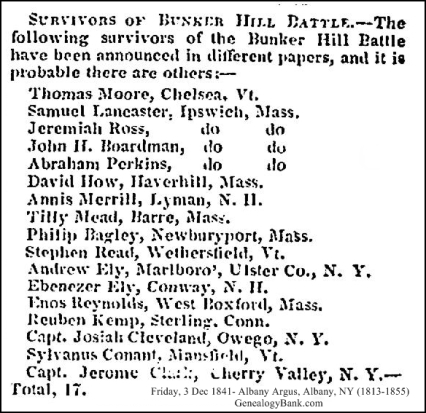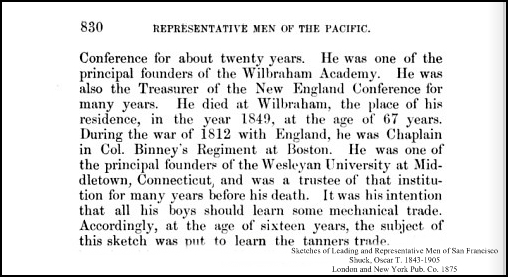Part Four
~As I researched the various “Amos Binney’s” I found a curious ‘disconnect’ of sorts about the Colonel that was very interesting. The Colonel, along with my third-Great grandfather, the Reverend Joseph A. Merrill, were very active within the Methodist Episcopal Church’s New England Conference and instrumental in the founding of The Wesleyan Academy at Newmarket. (The academy had at first been located in New Hampshire on two hundred and sixty acres of land donated by Reverend Merrill, and was then moved to Wilbraham, Massachusetts.)
At Newmarket and Wilbraham the Colonel was a trustee, and a president of the board. To the academy at Newmarket, he gave its largest contribution of $1,000, and to the academy at Wilbraham he donated a property worth $10,000 or $12,000. He was considered to be a great friend and aid to several churches, and to the Wilbraham Academy. It is interesting to note that he had donated an East Cambridge property that was valued at $11,500, but a defective title held up the acquisition for two years before the proceeds could be given to the academy at Newmarket.
The Colonel was considered to be a successful self-made man, a benevolent man, and a devout Methodist of sober character.
He was a member of a Masonic lodge, the president of the Vermont Copperas Works (which he started), President of the Worcester Rail Road and the Market Bank Boston. It is interesting to note that in the family genealogy he was noted as becoming, “well known to the community as an honest, upright, conscientious, able and generous man possessing extraordinary talents for business in the corporations and public institutions to which he belonged.”
After having read so many articles about his supposed questionable character in regards to his handling of the Navy yard I was beginning to wonder if I was reading about the correct Amos Binney! Based on the History of the Wesleyan Academy and the Genealogy of the Binney Family – I was. [1], [2]
I read the passages about him multiple times. And once again I came away wondering just what the Reverend Joseph A. Merrill must have thought when the man that he seemed to know so well in church and academy related matters came under such intense scrutiny and accusations.
Depending on which accounts you read – you can come away thinking that the Colonel was a scoundrel in disguise…or a saint when it came to matters of church and the education of New England’s youth.
He certainly seems to have done well in business ventures, and human nature being what it is, I come away wondering if he was not in fact facing jealousy among his peers. I can say that I have not found the Colonel as being charged with anything. Just accused.
The Reverend Amos Binney, noted as Binney family member number 101. Rev. Amos Binney(5), of New Haven, CT, Methodist Episcopal minister, son of Spencer (54) and Mary (Jones) Binney, of Hull, born in Hull, Saturday, Oct. 30, 1802; died in New Haven, CT, Friday, March 29, 1878, aged 75 years, 5 months [2]
Reverend Binney became a preacher of the Methodist Episcopal Church in July of 1821; an itinerant (traveling) minister in July of 1826. He joined the New England Conference in 1826, serving in the conference by regular appointment, except one year when he was an agent of the Wesleyan University in Middletown, Connecticut.
He was a member of the general court in 1852 and was partner with Reverend Otheman of “Binney & Otheman,” a Methodist book store located on Cornhill Street, Boston.
He was a presiding elder of the Springfield (Massachusetts) district from 1848-1850; in late 1850 he was transferred to the Lynn (Massachusetts) district where he served for four more years.
As a preacher he was considered to be plain, simple and evangelical. He preferred to “do good” rather than to be considered a “great preacher.” As a pastor he was considered diligent and earnest. Although he was not considered a theologian, he wrote a theological compendium of the Bible, as well as a book of missionary hymns.
After losing his first wife, Caroline (Wilder), he remarried in 1848, to Isabella Hill, a teacher at the (Wilbraham) Wesleyan Academy from 1845-1848, and then again (as Isabella H. Binney) from 1854-1857. The Reverend Binney had been a teacher there also, as well as a trustee member from 1845-1878, and President of the Board of Trustee’s from 1854-1856.
The Reverend Joseph A. Merrill was also a member of the Methodist Episcopal Church and the New England Conference, as well as a Board of Trustee member at the Wesleyan Academy from 1825-1849, and a treasurer from 1832-1842. Reverend Merrill lived in Wilbraham and the two men would have been in contact throughout their work for the New England Conference and the academy.
The Reverend Amos Binney seems to have led a devout and quiet life of service to his church and to the education of New England’s youth. Part of me would like to say that a man that lived his life without public blemish would have been the type of man to name a son after, yet I am certain that it is the Colonel that my third-Great uncle was named after. It is of no matter really as my third-Great uncle, Amos Binney Merrill, had no trouble carving out a name and identity for himself.
To be continued…
©2016 Amy McClosky
[1] History of the Wesleyan Academy at Wilbraham, Mass.
[2] Genealogy of the Binney Family
 *Cameo image from: Albany Argus, Friday, December 3, 1841, Albany, NY 1813-1855 via
*Cameo image from: Albany Argus, Friday, December 3, 1841, Albany, NY 1813-1855 via 


You must be logged in to post a comment.